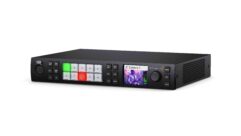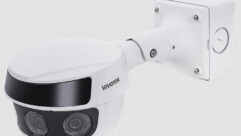
Picture This: Commodity Projections
Nov 1, 2007 12:00 PM,
By Jeff Sauer
Emerging markets for front-projector manufacturers.

Epson’s EnsembleHD home theater bundle includes a projector; a DVD player; a subwoofer; and an 80in.-to-100in. motorized screen with built-in center, right, and left loudspeakers. The projector mount has the rear surround
loudspeakers built in.
It’s no secret that front-projector prices have been falling for a few years now, and that’s great news for the consumer. With the baseline brightness and image quality going up and prices coming down, buyers are getting a better product for less money. And, lower prices have enticed new buyers into the market and convinced existing customers to upgrade to higher performing models. Yet lower prices also mean smaller margins for manufacturers and flat revenues for an industry that’s looking for a new wave of excitement.
In our annual Front Projectors Buyer’s Guide on p. 54, we list 95 XGA-resolution projectors that weigh less than 6.6lbs. with an average price of $1,450. That average compares to an average for the same resolution and size class in 2006 of $1,887. It is an average price drop on all projectors in the category — not the average price drop of individual projectors — and it reflects a higher percentage of affordable projectors in the class. Individual projectors that are in both this year’s and last year’s charts, as well as similar products, have dropped roughly 10 percent to 15 percent.
Still, of the 452 front projectors in our chart, almost half weigh less than 10lbs., and a great majority of them compete more on price than features. That sheer volume of projector models indicates a healthy marketplace for affordable business, training, and education projectors, and an industry that’s headed toward being a commodity business.
It’s an obvious trend. While the limited scope of such a vast chart can’t spell it out clearly, many of the projector models in the lower weight classes, particularly the SVGA and XGA products, are no-frills display products that simply use existing technology to put an image on a screen. The good news is that the base level of LCD and DLP technology has reached a level where good (or at least good enough) images are possible without spending a lot of money. However, these products lack anything more than very basic features and limited connectivity.
Manufacturers cut corners by using cheaper components, such as I/O circuitry and image processing, and that often results in compromised image quality if the source doesn’t share the native resolution of the projector. While there’s clearly a market for that type of generic product, those models make neither news nor much capital to reinvest in further R&D. And, if the industry is to stay healthy, it needs to innovate enough to get the new market customers to upgrade to higher performing, higher margin products before too long.
TECHNOLOGY PROJECTIONS
So where are the emerging markets for projection manufacturers moving forward? A good deal of the interest in the front projection industry over the last couple of years has been from motion video and home theater projectors, and that’s an area where there should still be a lot of room to grow with the trend toward home entertainment systems.
Today, 1080 projectors have quickly become the standard for quality, and that’s clearly tied to an increasing consumer awareness of high-definition video and HDTV. While some premium brands continue to offer 720p in a good/better/best hierarchy of products, the action is clearly with the 1080p. Does that leave room for 720p as a true value proposition for expanding the market?
It should, but it’s a market that demands creative thinking. A few companies (BenQ, Epson, Optoma, Toshiba, etc.) have tried to break into the affordable home theater market with DVD-projector combination products, but there is still a disconnect. Value buyers, in general, tend to have smaller houses that often don’t have a space to dedicate to an installation projector. That means they are more likely spend money on a larger flatpanel TV that can serve their everyday needs than add a product that might get used a few times a month. And with front projection there is always the question of a screen or display surface. A motorized screen in every home sounds like a great idea, but often times they cost more than the projector itself. Epson now offers a clever bundle that marries a 720p or 1080p Pro Cinema projector with a screen and built-in surround loudspeakers, thus offering an instant home theater for a few thousand dollars.
Emerging wireless HDMI solutions may also help the home theater market by eliminating cabling issues from the consumer equation. It’s a lot easier to move a projector onto a tabletop on “movie night” if a family doesn’t have to be stringing cables to a component cabinet. However, it will take time for those solutions to reach maturity and come down in price enough to reach beyond the premium sector. And there’s still the issue of a screen.
Wireless technology has already been around in business models for a few years with limited success, as has IP connectivity. Several manufacturers now include an RJ-45 Ethernet connector on individual projectors, although most do it for control. Some companies, such as Barco, Epson, and Sony, leverage that an Ethernet connection as a way to deliver content to the projector, thereby decreasing the need to carry a laptop to every presentation. Such habits die hard, however, and not many other companies have jumped on the bandwagon. On the other hand, some flatpanel markets are trying adding similar technology for digital signage applications, and that could be an area where front projection could find new markets, as well.
Palm-sized projectors have been around now for more than two years, and they bring with them exciting possibilities for completely different uses for front projection. Some of the ideas mentioned include using them on automobile dashboards; building projection into other devices such as cell phones, PDAs, and laptops; using them as an alternative to single-color flood lights for theaters and stores; and building a new category of personal projectors for movies and gaming. Unfortunately, LED light output is at least a couple of years away from being truly practical.
And, of course, digital cinema has been waiting in the wings of the industry with enormous potential, including high margins. It’s happening, but slowly. Meanwhile, the emergence of super-high-res projectors from Sony and a new 4K chipset from JVC, has opened other markets in virtual reality, simulation, and visualization in industries as diverse as automobile design, military, flight training, and medicine.
These are just a few examples of where projection might be headed in the future, but they ultimately have one very important factor in common — they represent solutions rather than just technology. As technology products, projectors are moving toward commodity status. Helping potential customers of all stripes solve problems, on the other hand, affords new opportunities.










